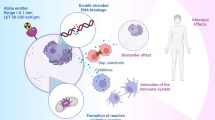Abstract
A new class of drugs, borylated derivatives of ferrocenium compounds, which show a comparatively facile synthesis is investigated on their boron neutron capture accumulation. Investigations focused on the fast and effective testing of 12 ferrocene derivatives with tetracoordinated boron atoms, which should accumulate in rodent tumors. The macroscopic studies on time-dependent boron distributions and boron concentrations in mice were carried out by inductively coupled plasma-atomic emission spectrometry, inductively coupled plasma-mass spectrometry, and quantitative neutron capture radiography. The determination of boron concentrations after injection of 2b showed high boron contents in spleen, liver, kidneys, less in lung and muscle, and poor in integral blood, blood plasma, tumor, and brain. It is interesting to note that 2b penetrates the blood-brain barrier which may be advantageous in the treatment of astrocytomas and glioblastomas.
Similar content being viewed by others
References
Alfassi ZB, Probst TU. 1999 On the calibration curve for the determination of boron in tissue by quantitative neutron capture radiography. Nucl Instr Meth Phys Res A 428, 502–507.
Coderre JA, Morris GM. 1999 The radiation biology of boron neutron capture therapy. Radiat Res 151, 1–18.
de Biani FF, Gmeinwieser T, Herdtweck E, Jäkle F, Laschi F, Wagner M, Zanello P. 1997 Multistep redox processes and intramolecular charge-transfer in ferrocene-based 2,20-bipyridylboronium salts. Organometallics 16, 4776–4787.
Flecknell P. 1997 Anaesthesia of Common Laboratory Species-Small Rodents. In Laboratory Animal Anaesthesia. London: Academic Press: 160–171.
Gahbauer R, Gupta N, Blue T, Goodmann J, Barth R, Grecula J, Soloway AH, Sauerwein W, Wambersie A. 1998 Boron neutron capture therapy: principles and potentials. Recent Results Cancer Res 150, 183–209.
Hawthorne F. 1993 The role of chemistry in the development of boron neutron capture therapy of cancer. Angew Chem Int Ed Engl 32, 950–998.
Herdtweck E, Jäkle F, Opromolla G, Spiegler M, Wagner M, Zanello P. 1996 Structural features and electrochemical properties of ansa-ferrocenes with pyrazabole bridges. Organometallics 15, 5524–5535.
Jäkle F, Priermeier T, Wagner M. 1995 Novel ansa-ferrocenes with o-phenylene-type bridges by B-N adduct formation. J Chem Soc Chem Commun 14, 1765–1766.
Jäkle F, Priermeier T, Wagner M. 1996 Synthesis, structure and dynamic behavior of ansa-ferrocenes with pyrazabole bridges. Organometallics 15, 2033–2040.
Köpf-Maier P, Köpf H, Neuse EW. 1984 Ferrocenium Salts-The First Antineoplastic Iron Compounds. Angew Chem Int Ed Engl 23, 456–457.
Köpf-Maier P, Köpf H, Neuse EW. 1984 Ferricenium Complexes: A New Type of Water-Soluble Antitumor Agent. J Cancer Res Clin Oncol 108, 336–340.
Köpf-Maier P, Köpf H. 1987 Non-platinum-group metal antitumor agent: history, current status and perspectives. Chem Rev 87, 1137–1152.
Kummermehr J. 1985 Measurement of tumour clonogenes in situ. In: Potten CS, Hendry JH. eds. Cell Clones: Manual of Mammalian Cell Techniques. Edinburgh: Churchill Livingstone: 215–222.
Locher GL. 1936 Biological effects and therapeutic possibilities of neutrons. Am J Roent 36, 1–13.
Probst TU. 1999 Methods for boron analysis in boron neutron capture therapy (BNCT). A review. Fresenius J Anal Chem 364, 391–403.
Probst T, Berryman N, Lemmen P, Weissfloch L, Auberger T, Gabel D, Carlsson J, Larsson B. 1997 A comparison of ICP-AES and ICP-MS with quantitative neutron capture radiography for the determination of boron in biological samples from cancer therapy. J Anal At Spectrom 12, 1115–1122.
Reichl FX. 1997 Taschenatlas der Toxikologie, Stuttgart: Georg Thieme Verlag.
Soloway AH, Barth RF, Gahbauer RA, Blue TE, Goodmann JH. 1997 The rationale and requirements for the development of boron neutron capture therapy of brain tumors. J Neuro-Oncol 33, 9–18.
Soloway AH, Tjarks W, Barnum A, Rong F-G, Barth RF, Codogni IM, Wilson JG. 1998 The chemistry of neutron capture therapy. Chem Revs 98, 1515–1562.
Weissfloch L, Auberger T, Wagner FM, Senekowitsch R, Tempel K, Molls M. 1997 Oxygen tensions in rodent tumors after irradiation with neutrons. Adv Exp Med Biol 411, 255–260.
Author information
Authors and Affiliations
Rights and permissions
About this article
Cite this article
Weissfloch, L., Wagner, M., Probst, T. et al. A new Class of Drugs for BNCT? Borylated derivatives of ferrocenium compounds in animal experiments. Biometals 14, 43–49 (2001). https://doi.org/10.1023/A:1016686321179
Issue Date:
DOI: https://doi.org/10.1023/A:1016686321179




